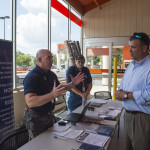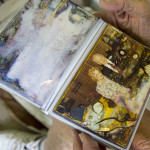Severe Flooding Affecting Areas throughout the Southeast
WASHINGTON –The Department of Homeland Security’s Federal Emergency Management Agency (FEMA) and its partners continue to mobilize resources and personnel to support state, local and tribal efforts as significant flooding impacts areas throughout the Southeast United States.
At the direction of President Obama, FEMA is leading the federal government’s efforts to provide assistance and support in the aftermath of Hurricane Matthew and is, on a daily basis, moving personnel and supplies into the affected areas.
Already, there are more than 750 FEMA personnel on the ground supporting response and recovery efforts including six Disaster Survivor Assistance (DSA) teams and six Incident Management Assistance Teams (IMATs) . Ten Urban Search & Rescue teams are also deployed and engaged in search and rescue efforts.
FEMA also prepositioned commodities throughout affected areas to ensure there are no unmet needs. FEMA made available more than 2.8 million meals, three million liters of water, and 48,000 blankets for state, tribal and local officials to distribute to individuals should they be requested by states.
A breakdown by state:
- Florida: More than 71,000 meals; 341,000 liters of water;
- Georgia: More than 579,000 meals, 649,000 liters of water; 17,000 blankets;
- North Carolina: More than 1.9 million meals; 1.6 million liters of water; 26,000 blankets; and,
- South Carolina: More than 250,000 meals; 390,000 liters of water; 4,500 blankets.
President Obama signed major disaster declarations Saturday for Florida and Georgia making federal funding available to state, tribal and eligible local governments and certain private non-profit organizations for debris removal and emergency protective measures for affected areas. This is in addition to pre-disaster emergency declarations signed earlier in the week by the President for Florida, Georgia, North Carolina and South Carolina. Damage assessments are underway and additional designations and forms of assistance may be added at a later date.
Ongoing Support and Preparedness Efforts:
The U.S. Army Corps of Engineers (USACE) deployed more than 100 personnel for Matthew response and is supporting eight FEMA mission assignments including dam inspections, flood-fight materials and temporary emergency power. USACE also continues participating in port surveys in the affected areas.
The Corporation for National and Community Service (CNCS) deployed more than 500 AmeriCorps members, including FEMA Corps, to areas affected by Hurricane Matthew. These deployments include 59 teams of FEMA Corps members – 471 AmeriCorps members in total – that have been pre-staged to support FEMA’s response to affected states. An additional 90 AmeriCorps members are supporting shelter and emergency operations in Florida and South Carolina. CNCS is coordinating with local partners in each state, including governor-appointed state service commissions and voluntary organizations, to support state emergency operations and volunteer response efforts.
The U.S. Department of Agriculture (USDA) encourages producers with crops insured under the Federal crop insurance program should immediately contact their local crop insurance agent to report any damage to insured crops after the storm. For assistance with Rural Development financed housing, business or community assistance information, and to get help from the Natural Resources Conservation Service for debris removal go to: http://offices.sc.egov.usda.gov/locator/app).
Additional disaster resource information as well as food safety, livestock and pet guidance is available at www.usda.gov. USDA Foods’ inventories have been requested from all potentially impacted state agencies, and the Supplemental Nutrition Assistance Program (SNAP) staff is prepared to respond to any state requests for disaster SNAP and/or other SNAP-related needs. Additional information about USDA’s disaster assistance resources is available at: http://www.usda.gov/wps/portal/usda/usdahome?navid=disaster-help.
The U.S. Department of Defense (DOD) established Incident Support Bases or Federal Staging Areas in Georgia, South Carolina and Virginia in coordination with FEMA to preposition commodities and resources close to the potentially affect areas. The U.S. Northern Command deployed Defense Coordinating Elements to Florida, Georgia, South Carolina, and North Carolina. These service members are providing DOD regional subject matter expertise, validate requirements, and conduct liaison efforts in support of response operations.
The U.S. Department of Health and Human Services’ Disaster Medical Assistance Team members from Pennsylvania are providing medical support to two hospitals in Brevard County, Florida. Additionally more than 1,000 personnel from the National Disaster Medical System, U.S. Public Health Service, and the Office of the Assistant Secretary for Preparedness and Response remain pre-positioned or on alert ready to assist in other communities.
The U.S. Department of Homeland Security in coordination with FEMA are working to ensure that individuals and communities affected by disasters do not face unlawful discrimination as they seek disaster-assistance services. The DHS Office for Civil Rights and Civil Liberties and both FEMA’s Office on Disability Integration and Coordination and the Office for Equal Rights issued an official memo to impacted states that there will be no immigration enforcement initiatives associated with evacuations, sheltering, or any other life-saving initiatives related to Matthew.
U.S. Coast Guard deployed a public health and safety officer to the National Response Coordination Center to support HHS related to Zika-virus issues that may occur following the recession of flood waters.
U.S. Citizenship and Immigration Services encourages those whose application, petition or immigration status may be impacted by Hurricane Matthew to call the USCIS National Customer Service Center at 800-375-5283 (TDD for the deaf and hard of hearing: 800-767-1833) to learn how to request certain types of relief. For more information, visit www.uscis.gov/humanitarian/special-situations.
The U.S. Department of Interior’s Bureau of Indian Affairs continues to coordinate with tribes in potentially affected areas as needed.
The U.S. Department of Interior’s United States Geological Survey deployed more than 40 teams to the affected areas to collect the 393 surge sensors and gauges that identify high water marks. USGS has additional crews making flood measurements and repairing stream gauges damaged by river flooding. Information on all sensors and gages is available at: http://stn.wim.usgs.gov/error.html.
The U.S. Department of Interior’s National Park Service is continuing to monitor and evaluate conditions at their parks. More than half a dozen national parks remain closed, each is assessing the ability to open to the public. Anyone planning to visit a park in the impacted states is encouraged to verify a park’s open status on its website.
Additionally, the Department of the Interior’s Office of Law Enforcement and Security continues to coordinate readiness to help with security. Two 25-person Quick Response Teams composed of U.S. Park Police and National Park Service, and U.S. Fish and Wildlife Service are assisting with protection for urban rescue teams and security for mobile field hospitals.
The U.S. Fish and Wildlife Service report 16 National Wildlife Refuges and other facilities remain closed with damage assessments of those facilities underway.
The Department of Justice has 500 federal law enforcement officers from across the country on standby and ready to deploy, as required.
The U.S. Environmental Protection Agency (EPA) activated the Regional Emergency Operations Center in Atlanta, Georgia and deployed liaisons to the FEMA Regional Response Coordination Center in Atlanta, and the state operational centers in Florida, North Carolina and South Carolina. All EPA regional programs have contacted their state counterparts and offered technical assistance concerning waste and debris disposal, water infrastructure, and fuel waiver issues. EPA deployed eight teams lead by Federal On-Scene Coordinators (OSC) to conduct oil and hazardous materials assessment activities in the Florida coastal counties of Nassau, Duval, St. Johns, Flagler, Volusia, and Brevard.
The Federal Aviation Administration is warning drone operators to stay clear of hurricane rescue and response aircraft to preserve the safety of first-responders.
The Federal Motor Carrier Safety Administration (FMCSA) divisions in the southern region continue working with contact permitting agencies & commercial motor vehicle law enforcement agencies in their states to assist with necessary emergency waivers and permits.
The U.S. General Services Administration (GSA) deployed staff to Florida, Georgia, and South Carolina to support FEMA efforts to establish Joint Field Offices and Disaster Response Centers. GSA assessment teams are preparing to survey potential damage to federal facilities and will ensure any necessary repairs are undertaken quickly.
National Center for Missing & Exploited Children (NCMEC) activated its Unaccompanied Minors Registry (UMR). Family members can go to https://umr.missingkids.org or call 1-800-THE-LOST to find unaccompanied children who may have been separated from parents or caregivers because of the floods, by entering basic information and/or a photo.
The National Guard continues to move north following the storm’s path. More than 9,000 National Guard personnel from nine states are conducting search and rescue, security, infrastructure assessment, route clearance, and communications in support of hurricane recovery efforts. The National Guard provides support to civil authority of the state under direction of the governor.
The American Red Cross continues supporting a massive shelter operation in the affected areas. More than 13,400 people stayed the night in 248 Red Cross and community evacuation shelters in Florida, Georgia, South Carolina and North Carolina. The Red Cross has more than 2,700 trained disaster workers on the ground in addition to 133 pre-positioned response vehicles and 97 trailer loads filled water, ready-to-eat meals, shelter and kitchen supplies, cleaning supplies and comfort kits, insect repellant, gloves, masks, shovels, rakes, coolers and more. For Hurricane Matthew shelter locations, visit www.redcross.org or call 1-800-768-8048. The American Red Cross has an urgent need for blood and platelet donations as Hurricane Matthew has forced the cancellation of many blood drives. Residents who are in an unaffected area, are encouraged to give blood or platelets, to help patients in the affected areas with great need. Go to redcrossblood.org or call 1-800-RED CROSS.
The Department of Transportation’s (DOT) Federal Highway Administration deployed about a dozen personnel from division offices to assist with the storm response. Bridge and road inspectors will make damage assessments in affected areas are beginning.
The Department of Treasury’s Internal Revenue Service (IRS) advises that the latest guidance for taxpayers affected by Matthew will be available at https://www.irs.gov/uac/newsroom/news-releases-for-current-month.
For up-to-date information about U.S. Department of Veterans Affairs facilities can be found at: http://www.blogs.va.gov/VAntage/31765/va-facilities-across-the-southeast-prepare-for-hurricane-matthew/.
The U.S. Agency for International Development’s Office of U.S. Foreign Disaster Assistance teams are deployed to Haiti, Jamaica and the Bahamas and are working with local authorities to coordinate relief efforts. Updates on the status operations throughout the Caribbean are available on travel.state.gov and on individual Embassy websites. U.S. citizens traveling and residing abroad are encouraged to enroll their travel plans on the agency’s website, travel.state.gov, using the Smart Traveler Enrollment Program (STEP), and to read the “Country Specific” information also found on the site.
FEMA advises anyone in the impacted areas looking to help or assist with response and recovery efforts can get involved by contacting their American Red Cross chapter or their local Voluntary Organizations Active in Disaster (VOAD) chapter to connect to many organizations working on the ground that are in need of volunteers. To get in touch with the local VOAD in the affected areas, visit:
- http://flvoad.communityos.org/cms/
- https://scvoad.communityos.org/cms/home
- https://gavoad.communityos.org/cms/home
- https://vavoad.communityos.org/”
For additional info, imagery, graphics and b-roll, see our Hurricane Matthew web page: http://www.fema.gov/hurricane-matthew.
###
FEMA’s mission is to support our citizens and first responders to ensure that as a nation we work together to build, sustain and improve our capability to prepare for, protect against, respond to, recover from and mitigate all hazards.
Follow FEMA online at www.fema.gov/blog, www.twitter.com/fema, www.facebook.com/fema and www.youtube.com/fema. Also, follow Administrator Craig Fugate’s activities at www.twitter.com/craigatfema.
The social media links provided are for reference only. FEMA does not endorse any non-government websites, companies or applications.
Link:
Federal Resources Supporting Response to Aftermath of Hurricane Matthew








